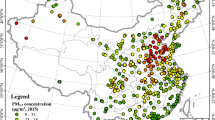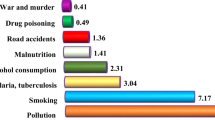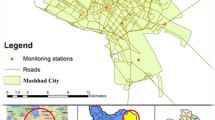Abstract
Accurate measurements of PM2.5 concentration over time and space are especially critical for reducing adverse health outcomes. However, sparsely stationary monitoring sites considerably hinder the ability to effectively characterize observed concentrations. Utilizing data on meteorological and land-related factors, this study introduces a radial basis function (RBF) neural network method for estimating PM2.5 concentrations based on sparse observed inputs. The state of Texas in the USA was selected as the study area. Performance of the RBF models was evaluated by statistic indices including mean square error, mean absolute error, mean relative deviation, and the correlation coefficient. Results show that the annual PM2.5 concentrations estimated by the RBF models with meteorological factors and/or land-related factors were markedly closer to the observed concentrations. RBF models with combined meteorological and land-related factors achieved best performance relative to ones with either type of these factors only. It can be concluded that meteorological factors and land-related factors are useful for articulating the variation of PM2.5 concentration in a given study area. With these covariate factors, the RBF neural network can effectively estimate PM2.5 concentrations with acceptable accuracy under the condition of sparse monitoring stations. The improved accuracy of air concentration estimation would greatly benefit epidemiological and environmental studies in characterizing local air pollution and in helping reduce population exposures for areas with limited availability of air quality data.





Similar content being viewed by others
References
Adams HS, Nieuwenhuijsen MJ, Colvile RN (2001) Determinants of fine particle (PM2.5) personal exposure levels in transport microenvironments, London, UK. Atmos Environ 35:4557–4566
Bell ML, Ebisu K (2012) Environmental inequality in exposures to airborne particulate matter components in the United States. Environ Health Perspect 120:1699–1704
Bellander T, Berglind N, Gustavsson P, Jonson T, Nyberg F, Pershagen G, Järup L (2001) Using geographic information systems to assess individual historical exposure to air pollution from traffic and house heating in Stockholm. Environ Health Perspect 109:633–639
US Census Bureau (2013) http://www.census.gov/main/www/access.html. Accessed 10 Jan 2013
Charron A, Harrison RM (2005) Fine (PM2.5) and coarse (PM2.5-10) particulate matter on a heavily trafficked London highway: sources and processes. Environ Sci Technol 39:7768–7776
Chen Y, Shi R, Shu S, Gao W (2013) Ensemble and enhanced PM10 concentration forecast model based on stepwise regression and wavelet analysis. Atmos Environ 74:346–359
Cheng YH, Chang HP, Hsieh CJ (2011) Short-term exposure to PM10, PM2.5, ultrafine particles and CO2 for passengers at an intercity bus terminal. Atmos Environ 45:2034–2042
Cyrys J, Heinrich J, Hoek G, Meliefste K, Lewné M, Gehring U, Brunekreef B (2003) Comparison between different traffic-related particle indicators: elemental carbon (EC), PM2.5 mass, and absorbance. J Expo Sci Environ Epidemiol 13:134–143
Eeftens M, Beelen R, de Hoogh K, Bellander T, Cesaroni G, Cirach Marta et al (2012) Development of land use regression models for PM2.5, PM2.5 absorbance, PM10 and PM coarse in 20 European study areas; results of the ESCAPE project. Environ Sci Technol 46:11195–11205
U.S. EPA (2013) United States Environmental Protection Agency Air Data. http://www.epa.gov/airquality/airdata/ad_data_daily.html. Accessed 15 Jan 2013
ESRI (2013) ESRI nationwide street and geocoding database. http://www.esri.com/metadata/esriprof80.dtd. Accessed 5 Jan 2013
Fang MJ, Zhu GC, Zheng XX, Yin ZY (2011) Study on air fine particles pollution prediction of main traffic route using artificial neural network. Computer Distributed Control and Intelligent Environmental Monitoring (CDCIEM), 2011 International Conference on IEEE, 1346–1349
Hao Y, Flowers H, Monti MM, Qualters JR (2012) US census unit population exposures to ambient air pollutants. Int J Health Geogr 11. doi:10.1186/1476-072X-11-3
Hrust L, Klaić ZB, Križan J, Antonić O, Hercog P (2009) Neural network forecasting of air pollutants hourly concentrations using optimized temporal averages of meteorological variables and pollutant concentrations. Atmos Environ 43:5588–5596
Karvosenoja N, Kangas L, Kupiainen K, Kukkonen J, Karppinen A, Sofiev M et al (2011) Integrated modeling assessments of the population exposure in Finland to primary PM2.5 from traffic and domestic wood combustion on the resolutions of 1 and 10 km. Air Qual Atmos Health 4:179–188
Lamraoui M, Barakat M, Thomas M, Badaoui ME (2013) Chatter detection in milling machines by neural networks classification and feature selection. J Vib Control. doi: 10.1177/1077546313493919
Lee HJ, Liu Y, Coull BA, Schwartz J, Koutrakis P (2011) A novel calibration approach of MODIS AOD data to predict PM2.5 concentrations. Atmos Chem Phys 11:9769–9795
Lee SJ, Serre ML, van Donkelaar A, Martin RV, Burnett RT, Jerrett M (2012) Comparison of geostatistical interpolation and remote sensing techniques for estimating long-term exposure to ambient PM2.5 concentrations across the continental United States. Environ Health Perspect 120:1727–1732
Leiva GMA, Santibañez DA, Ibarra ES, Matus CP, Seguel R (2013) A five-year study of particulate matter (PM2.5) and cerebrovascular diseases. Environ Pollut 181:1–6
Levy RC, Remer LA, Mattoo S, Vermote EF, Kaufman YJ (2007) Second-generation operational algorithm: retrieval of aerosol properties over land from inversion of Moderate Resolution Imaging Spectroradiometer spectral reflectance. J Geophys Res 112. doi:10.1029/2006JD007811
Li H, Zhang X, Lan L, Sun Z (2003) A optimum design of RBF neural networks based on genetic algorithms. Comput Simul 20:67–69 (in Chinese)
Losser T, Li L, Piltner (2014) A spatiotemporal interpolation method using radial basis functions for geospatiotemporal big data. Computing for Geospatial Research and Application (COM. Geo), 2014 Fifth International Conference on IEEE, 17–24
Lu WZ, Wang WJ, Wang XK, Yan SH, Lam JC (2004) Potential assessment of a neural network model with PCA/RBF approach for forecasting pollutant trends in Mong Kok urban air, Hong Kong. Environ Res 96:79–87
Makkonen U, Hellén H, Anttila P, Ferm M (2010) Size distribution and chemical composition of airborne particles in south-eastern Finland during different seasons and wildfire episodes in 2006. Sci Total Environ 408:644–651
Mao L, Qiu Y, Kusano C, Xu X (2012) Predicting regional space–time variation of PM2.5 with land-use regression model and MODIS data. Environ Sci Pollut Res 19:128–138
Moody J, Darken CJ (1989) Fast learning in networks of locally-tuned processing units. Neural Comput 1:281–294
Morgenstern V, Zutavern A, Cyrys J, Brockow I, Gehring U, Koletzko S, Heinrich J (2007) Respiratory health and individual estimated exposure to traffic-related air pollutants in a cohort of young children. Occup Environ Med 64:8–16
NCDC (2013) ftp://ftp.ncdc.noaa.gov/pub/data/noaa. Accessed 5 Jan 2013
NOAA (2013) http://raob.fsl.noaa.gov/. Accessed 5 Jan 2013
Oftedal B, Walker SE, Gram F, McInnes H (2009) Modelling long-term averages of local ambient air pollution in Oslo, Norway: evaluation of nitrogen dioxide, PM10 and PM2.5. Int J Environ Pollut 36:110–126
Ordieres JB, Vergara EP, Capuz RS, Salazar RE (2005) Neural network prediction model for fine particulate matter (PM2.5) on the US–Mexico border in El Paso (Texas) and Ciudad Juárez (Chihuahua). Environ Model Softw 20:547–559
Pérez P, Trier A, Reyes J (2000) Prediction of PM2.5 concentrations several hours in advance using neural networks in Santiago, Chile. Atmos Environ 34:1189–1196
Samia A, Kaouther N, Abdelwahed T (2012) A hybrid ARIMA and artificial neural networks model to forecast air quality in urban areas: case of Tunisia. Adv Mater Res 518:2969–2979
USGS (2013) USGS land cover database. http://seamless.usgs.gov/. Accessed 13 Jan 2013
Voukantsis D, Karatzas K, Kukkonen J, Räsänen T, Karppinen A, Kolehmainen M (2011) Intercomparison of air quality data using principal component analysis, and forecasting of PM10 and PM2.5 concentrations using artificial neural networks, in Thessaloniki and Helsinki. Sci Total Environ 409:1266–1276
Wan N, Zhan FB, Zou B, Chow E (2012a) A relative spatial access assessment approach for analyzing potential spatial access to colorectal cancer services in Texas. Appl Geogr 32:291–299
Wan N, Zou B, Sternberg T (2012b) A 3-step floating catchment area method for analyzing spatial access to health services. Int J Geogr Inf Sci 26:1073–1089
Wan N, Zhan FB, Zou B, Wilson JG (2013) Does spatial access to healthcare services explain disparities in colorectal cancer stage at diagnosis. Prof Geogr 65:527–541
Wilson JG, Zawar-Reza P (2006) Intraurban-scale dispersion modelling of particulate matter concentrations: applications for exposure estimates in cohort studies. Atmos Environ 40:1053–1063
Wilson JG, Kingham S, Pearce J, Sturman AP (2005) A review of intraurban variations in particulate air pollution: implications for epidemiological research. Atmos Environ 39:6444–6462
Yao L, Lu N, Jiang S (2012) Artificial neural network (ANN) for multi-source PM2.5 estimation using surface, MODIS, and meteorological data. Biomedical Engineering and Biotechnology (iCBEB), 2012 International Conference on. IEEE, 1228–1231
Yu S, Mathur R, Schere K, Kang D et al (2008) Evaluation of real-time PM2.5 forecasts and process analysis for PM2.5 formation over the eastern United States using the Eta-CMAQ forecast model during the 2004 ICARTT study. J Geophys Res Atmos (1984–2012) 113. doi:10.1029/2007JD009226
Yue H, Zhang HJ, Chai TY (2006) Strategic study of RBF neural network parameter optimization. Control Eng China 13:525–529
Zanobetti A, Franklin M, Koutrakis P, Schwartz J (2009) Fine particulate air pollution and its components in association with cause-specific emergency admissions. Environ Health 8. doi:10.1186/1476-069X-8-58
Zhang H, Chai Y (2012) Improved method for RBF neural network parameters optimization. Comput Eng Appl 48:146–149 (in Chinese)
Zhao Y, Hasan YA (2013) Machine learning algorithms for predicting roadside fine particulate matter concentration level in Hong Kong Central. Comput Ecol Softw 3:61–73
Zheng H, Shang X (2013) Study on prediction of atmospheric PM2.5 based on RBF neural network. Digital Manufacturing and Automation (ICDMA), 2013 Fourth International Conference on IEEE, 1287–1289. doi:10.1109/ICDMA.2013.306
Zou B, Wilson JG, Zhan FB, Zeng Y (2009) Air pollution exposure assessment methods utilized in epidemiological studies. J Environ Monit 11:475–490
Zou B, Wilson JG, Zhan FB, Zeng Y, Wu K (2011a) Spatial-temporal variations of regional ambient sulfur dioxide concentration and source contribution analysis: a dispersion modeling approach. Atmos Environ 45:4977–4985
Zou B, Zhan FB, Zeng Y, Yorke C, Liu X (2011b) Performance of Kriging and EWPM for relative air pollution exposure risk assessment. Int J Environ Res 5:769–778
Zou B, Peng F, Wan N, Wilson JG, Xiong Y (2014a) Sulfur dioxide exposure and environmental justice: a multi–scale and source–specific perspective. Atmos Pollut Res 5:491–499
Zou B, Peng F, Wan N, Mamady K, Wilson GJ (2014b) Spatial cluster detection of air pollution exposure inequities across the United States. PLoS ONE 9(3):e91917. doi:10.1371/journal.pone.0091917
Zou B, Luo Y, Wan N, Zheng Z, Sternberg T, Liao Y (2015) Performance comparison of LUR and OK in PM2.5 concentration mapping: a multidimensional perspective. Sci Rep 5:8698. doi:10.1038/srep08698
Acknowledgment
The research work was supported by the National Natural Science Foundation of China (No. 41201384), the Hunan Provincial Natural Science Foundation of China (No. 12JJ3034), the Opening Project of Shanghai Key Laboratory of Atmospheric Particle Pollution and Prevention (LAP3), and the State Key Laboratory of Resources and Environmental Information System. Bin Zou would also like to thank the grant from the Key Laboratory of Geo-informatics of State Bureau of Surveying and Mapping (No. 201228, 2014JC07), as well as the NieYing Talent Program of Central South University. Wan Ming thanks the support of an innovative project for graduated students in Central South University (No. 2014zzts253).
Author information
Authors and Affiliations
Corresponding author
Additional information
Responsible editor: Michael Matthies
Rights and permissions
About this article
Cite this article
Zou, B., Wang, M., Wan, N. et al. Spatial modeling of PM2.5 concentrations with a multifactoral radial basis function neural network. Environ Sci Pollut Res 22, 10395–10404 (2015). https://doi.org/10.1007/s11356-015-4380-3
Received:
Accepted:
Published:
Issue Date:
DOI: https://doi.org/10.1007/s11356-015-4380-3




